This simple 5-minute, no-cook century egg recipe will show you how to recreate those childhood flavors you know and love; this Chinese delicacy is timeless for a reason! Enjoy your creamy 1000-year-old egg with tender silken tofu that’s blanketed by a bath of soy paste and sesame oil. And if you've never tried it before, you're in for a savory and umami-rich first bite.

jump to:
✨ why you'll love this recipe
I love recipes steeped in both history and flavor, and this one certainly fits the bill. Century eggs were first thought to be made over 600 years ago around the Ming Dynasty and we still enjoy them (oftentimes made through the same exact process our ancestors used) today. Isn’t there something so sacred about that?
Of course, the history probably wouldn’t be as cool if the dish didn’t taste so good, but thankfully it does! This aged egg recipe is basically a ton of flavor wrapped in a small package.
It’s also super versatile. I like to mix and match toppings with soft or silken tofu. You can try looking at my other cold silken tofu recipe if you're not feeling this one.
Since this dish is served cold like a salad, you might like a cozy soup to go along with it or a side of easy Taiwanese water spinach. Regardless, I hope you enjoy this flavorful and nourishing dish as much as I do!
🥚 what are century eggs
Century eggs are known as 皮蛋 (pí dàn) in Chinese or bé-nn̄g in Taiwanese. Other English names include 1000 year old egg, 100 year old egg, black duck egg, preserved duck egg, Chinese black egg, and more!
But, they're not actually a century or 1000 years old as the English name suggests.
They're actually preserved/fermented eggs by a chemical process that changes the egg's pH. This process allows it to exist without going bad for...a century! (Or at least, a very long time.)
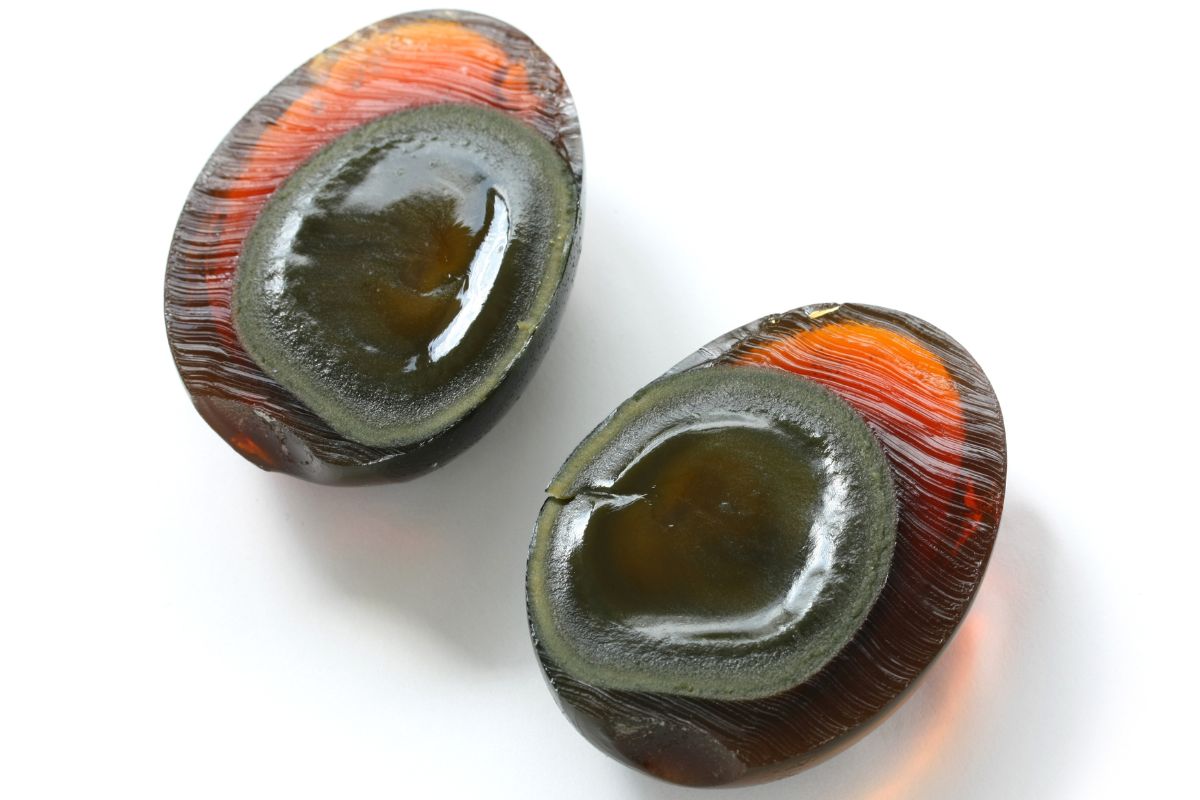
Through the fermentation process, the egg whites turn translucent brown and jelly-like with a salty umami flavor. It's my favorite part! The texture and color are very similar to aspic or meat gelatin/jelly.
The yolks look greenish-gray and are super creamy. The richness of flavor and texture is why they're considered such a delicacy to those that didn't grow up eating them. To the Taiwanese and Chinese diaspora around the world, however, it might be a comfort food you look forward to eating.
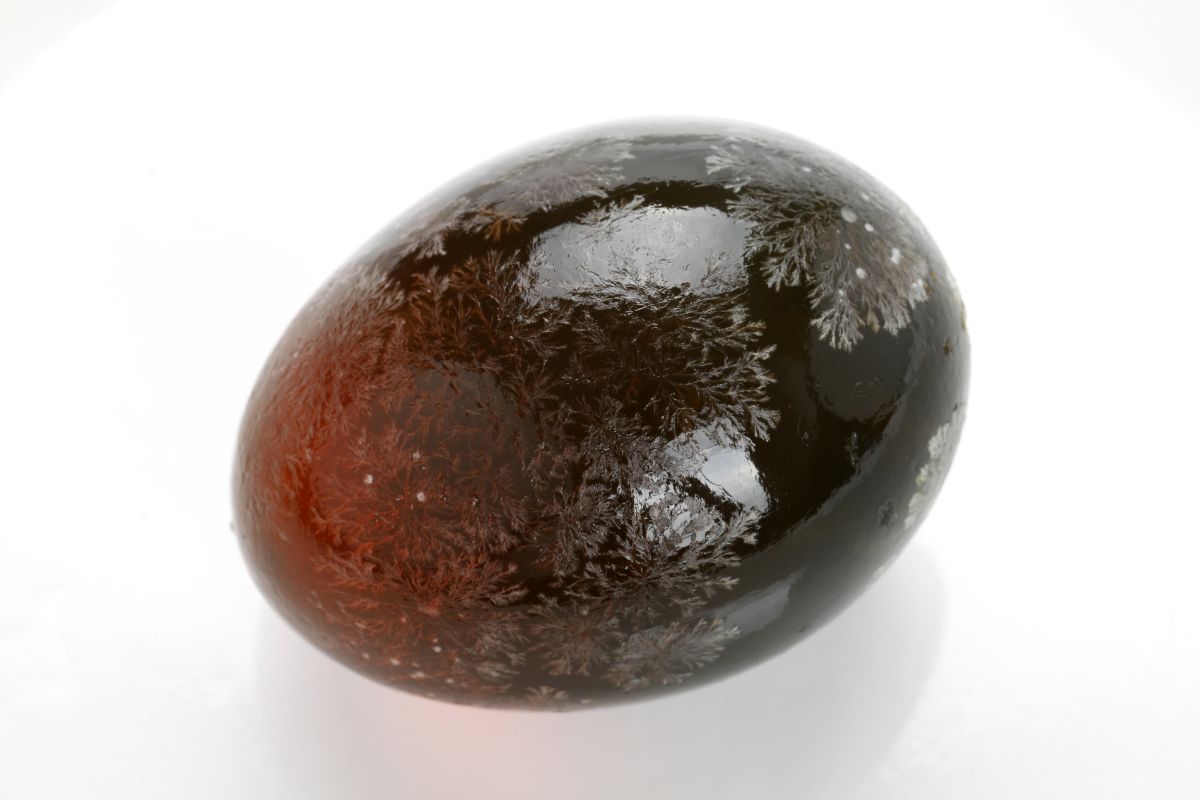
Note: the photo above shows the crystallization pattern that's sometimes seen in the egg "whites." It's totally okay to eat - in fact, it's often considered to be a better egg if it has that snowflake-like pattern on it.
📋 key ingredients
This century egg recipe doesn't require many ingredients because the egg has so much flavor all on its own. However, I also made this recipe with the flavor profile that's commonly found in Taiwanese restaurants.
With just a handful of ingredients, this recipe has the perfect combination of flavors that bring out the umami in the egg and complement the silken tofu.
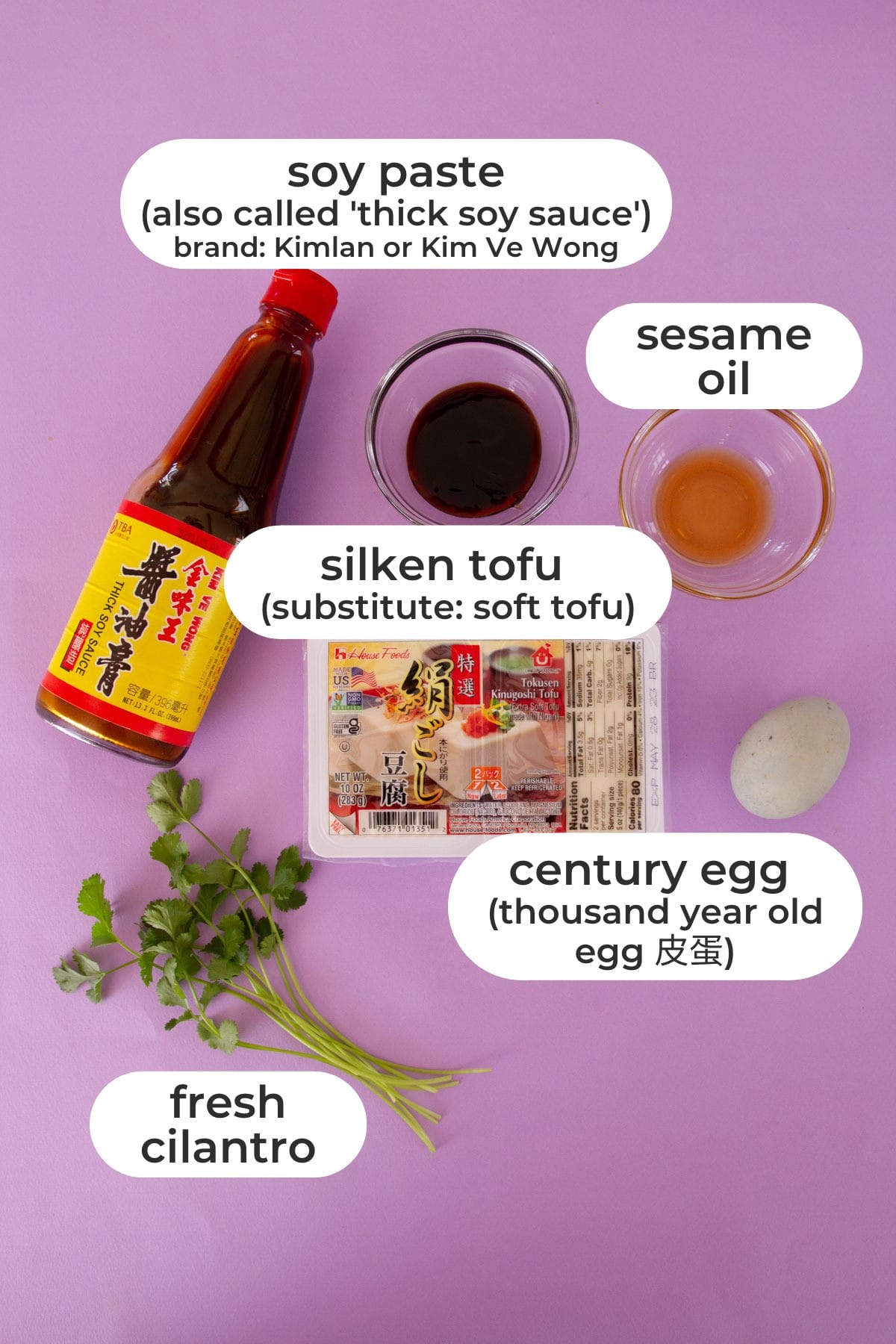
- century egg - also known as thousand-year-old egg 皮蛋 (pídàn). This can be found in the refrigerated section at Taiwanese and Chinese grocery stores like 99 Ranch Market or online at Weee! (affiliate link), usually sold by half a dozen and packaged in a rectangular box that's wrapped with plastic.
- soy paste - it's sometimes labeled as thick soy sauce. Kimlan (affiliate link) is a go-to brand for Taiwanese households. I always have a bottle stocked in my refrigerator.
- silken tofu - usually located in the refrigerated section at Taiwanese, Chinese, Japanese, and Korean grocery stores
- sesame oil - any toasted sesame oil will work
- fresh cilantro - this dish is traditionally served with cilantro, but you can substitute with scallions if you're not a fan.
See recipe card for quantities.
📖 substitutions
There's no good substitute for a century egg. If you don't have it on hand, you can simply omit it and enjoy silken tofu with the sauce only, though it won't taste the same.
- gluten-free - use a soy sauce and soy paste that's brewed without wheat like the ones at Yun Hai.
- silken tofu substitute - Soft tofu would work for this recipe too, though the tofu won’t be as silky smooth. Most of the soft tofu found in large grocery stores are 14-16 ounces per package. When using, drain the tofu and cut it in half. See storage notes below on how to store unused tofu.
🔪 instructions
I’m going to go through each step in detail below, including step-by-step photos of how to cut the century egg. In a hurry? You can jump straight to the recipe card.
Remove the century egg from its original container (sometimes they're individually wrapped in plastic as well). You may notice a stronger smell right after removing it from its packaging but don't worry, it'll mellow out and won't taste like how it smells.
Place the egg on a cutting board and lightly press it with the palm of your hand while you roll it back and forth until the shell loosens. Peel the shell off as you would a hard-boiled egg.
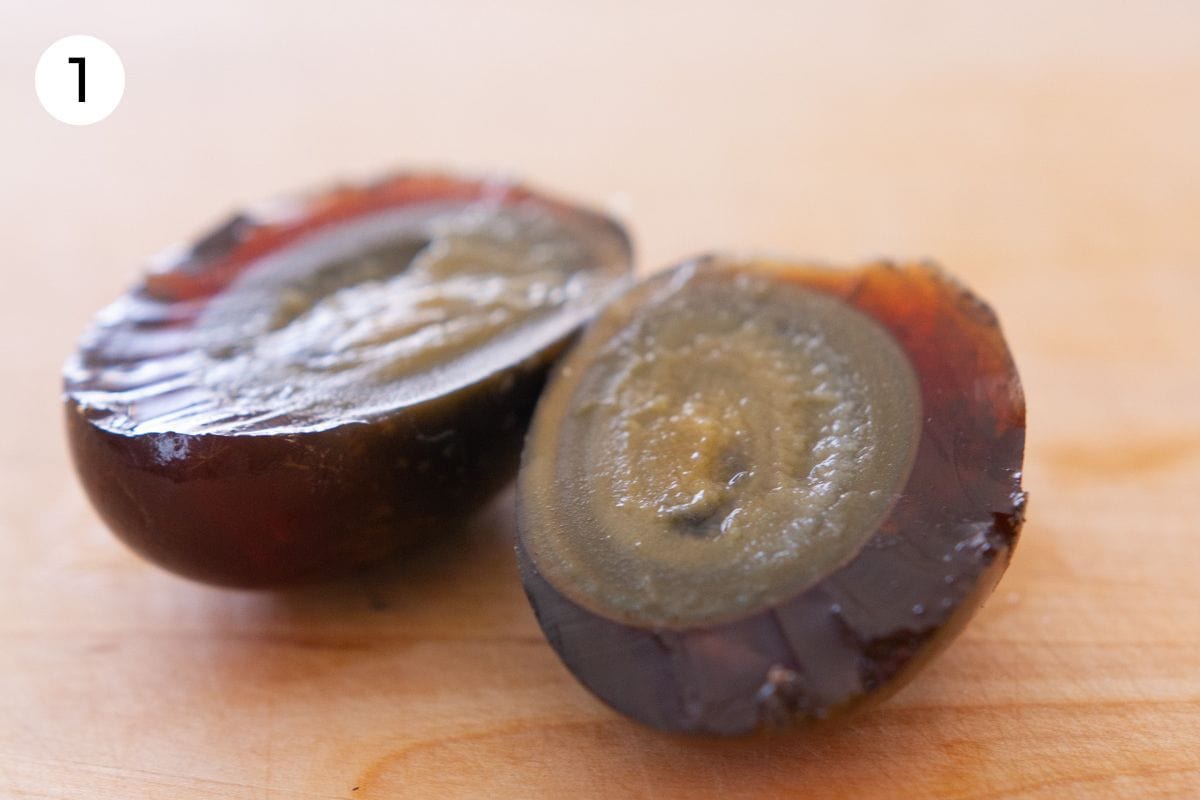
Slice the century egg in half, length-wise.
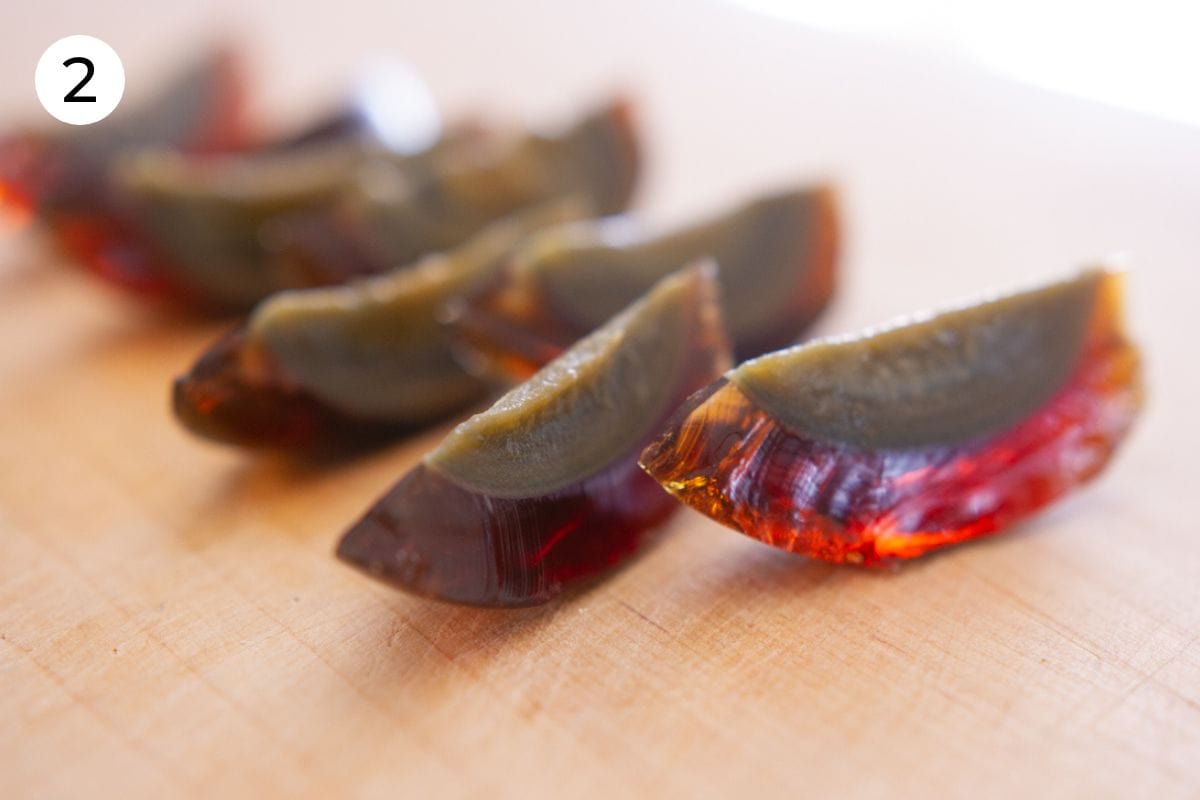
Slice each half into 4 wedges, making a total of 8 wedges. Since the yolk is creamy and tends to stick to the knife, it helps to wipe your knife with a damp paper towel between slices.
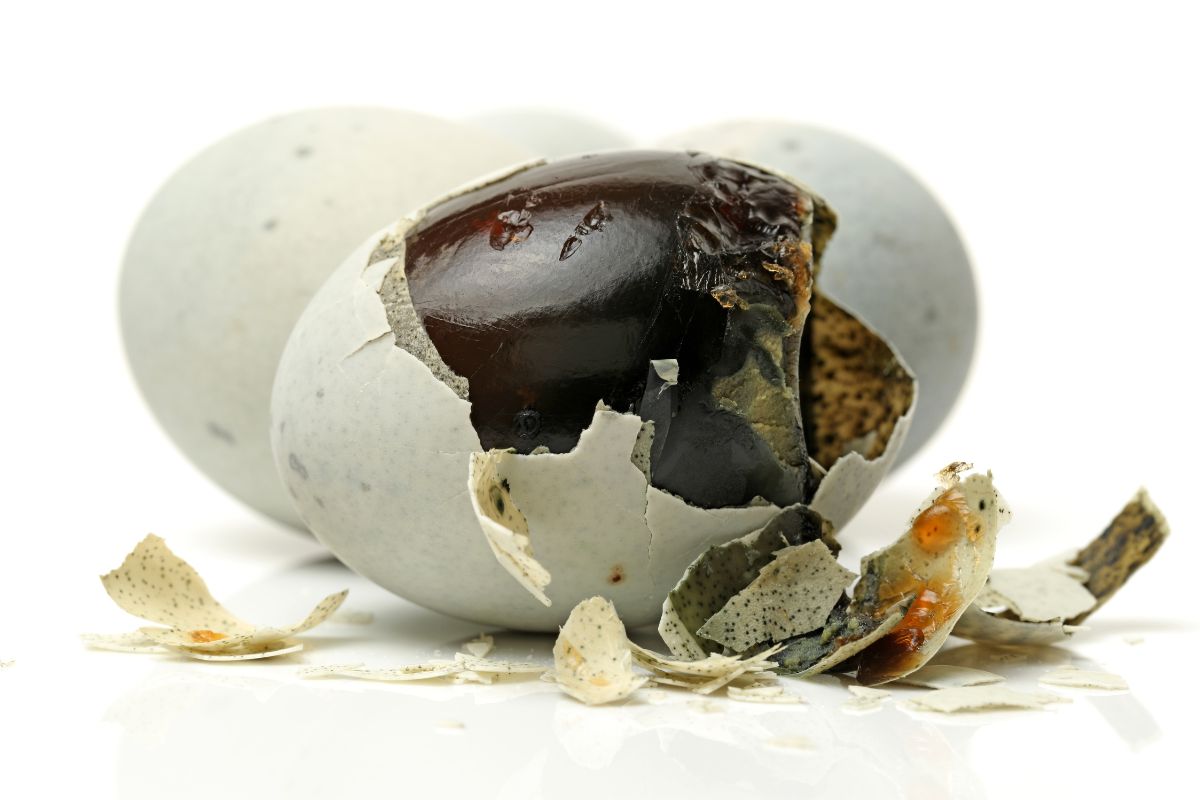
Alternatively, if you find that the century egg is difficult to peel, you can try cracking the shell with a chef's knife and cutting it in half before peeling.
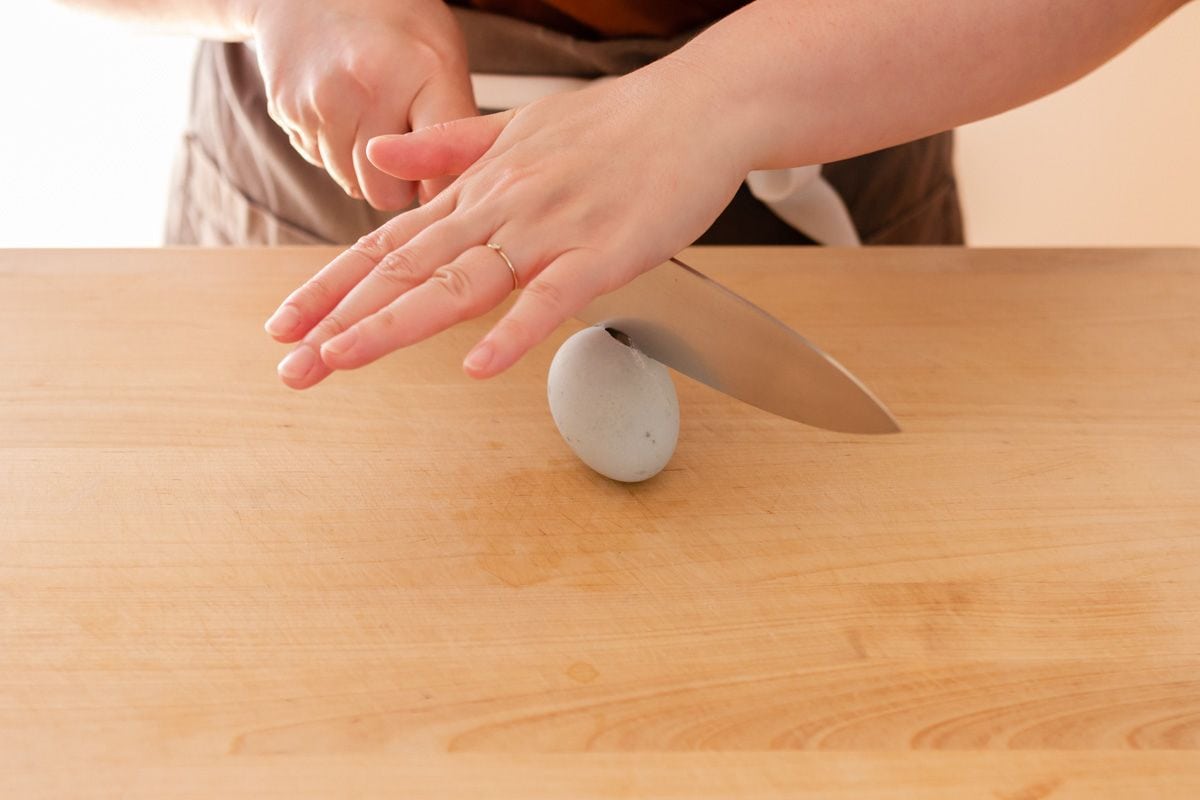
Crack the side of the shell with a chef's knife so the egg doesn't slip when cutting.
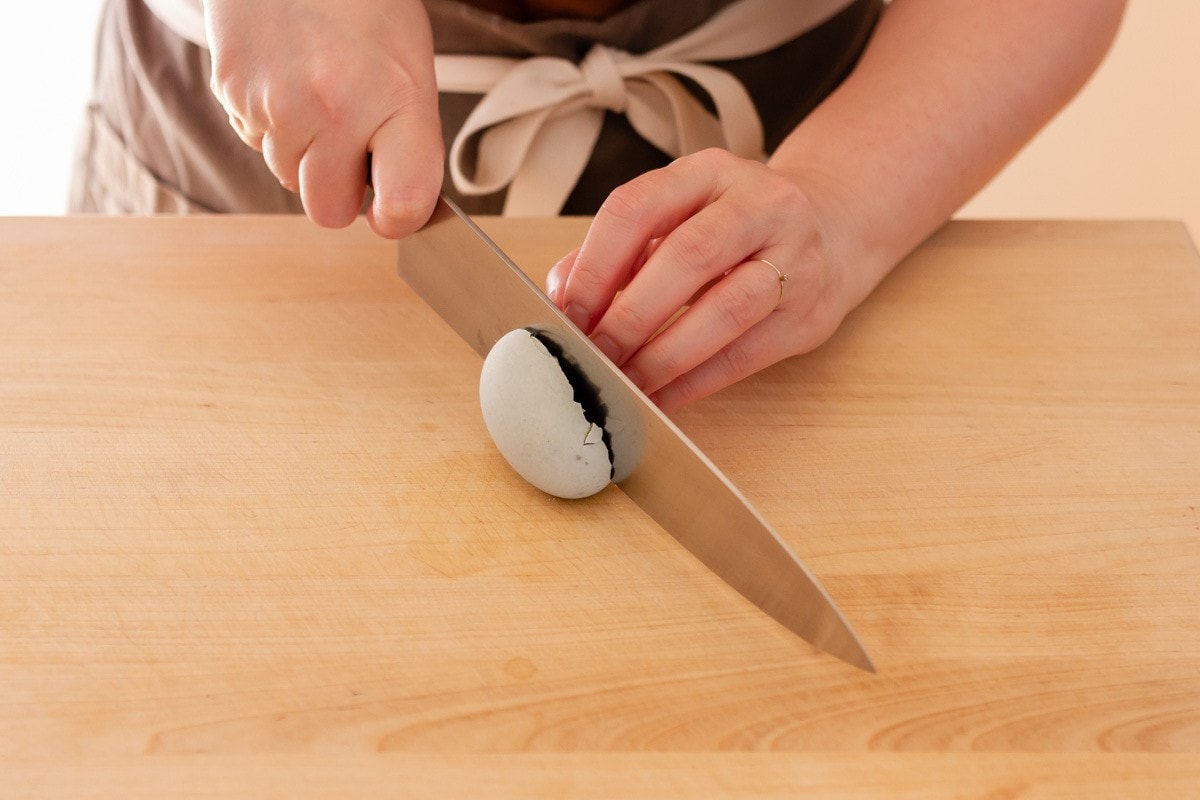
Cut in half and peel the shell off by hand. Then, rinse under running cold water to wash off any eggshell debris.
Now, drain and plate the silken tofu as shown below.
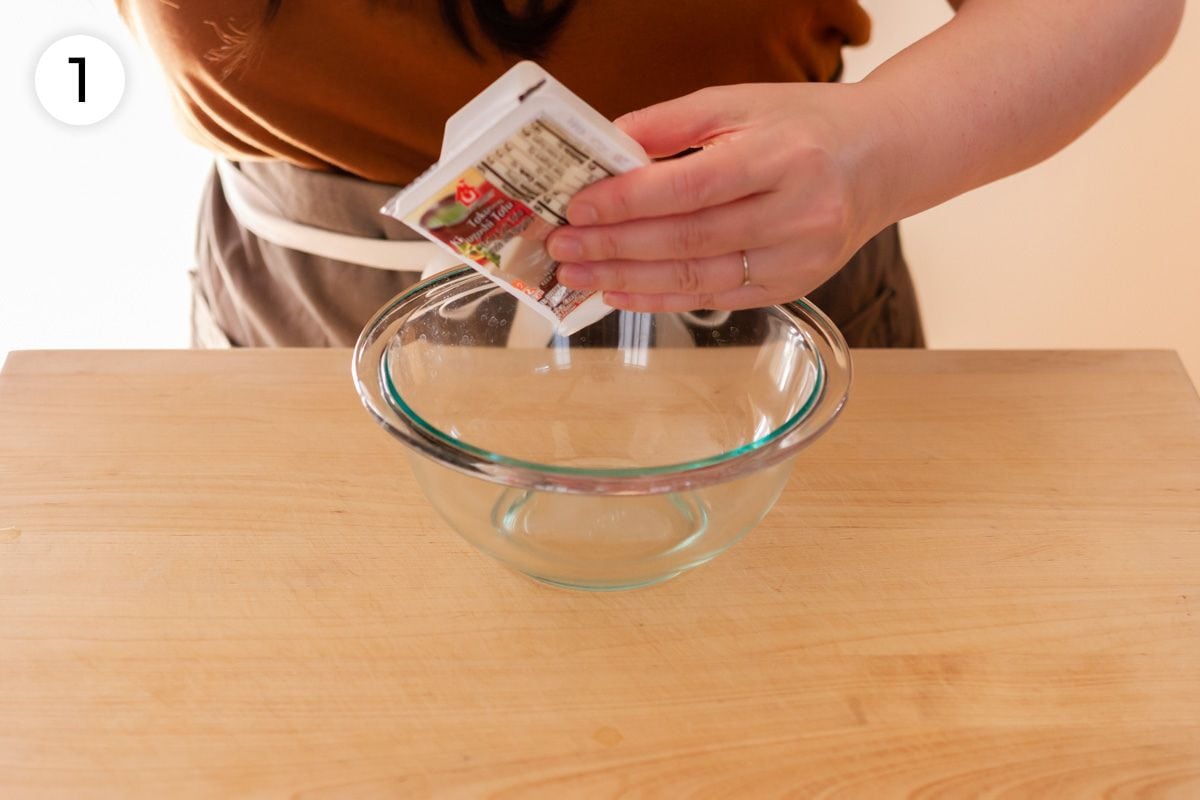
Peel back the cover of the silken tofu container and drain the liquid over a bowl or sink. If the cover is difficult to peel, kitchen sheers or a sharp paring knife will help.

Place a small serving plate or shallow bowl upside down over the top of the tofu container, then flip so that the container is upside down. Gently squeeze both sides of the container until the silken tofu is released.
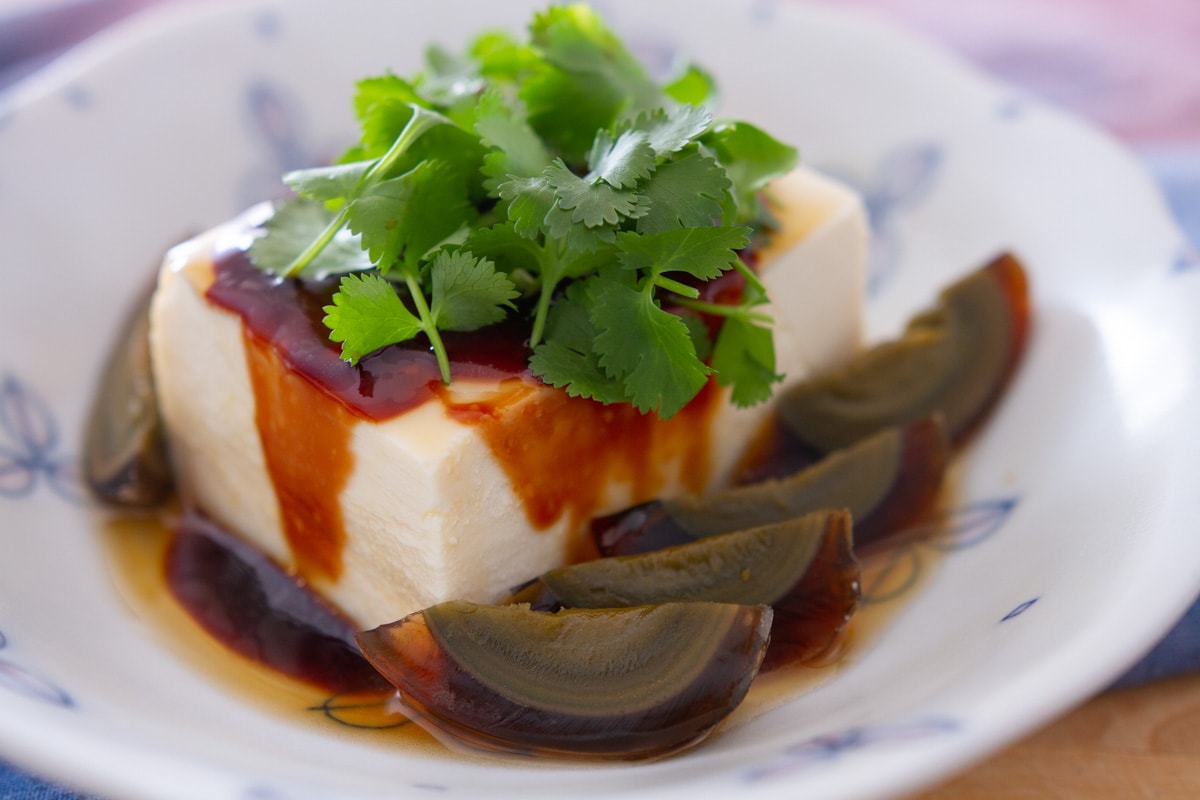
Place sliced century egg on the serving plate next to the silken tofu, then top tofu with soy paste, sesame oil, and fresh cilantro. Serve immediately, cold or chilled.
pro tip: this century egg tofu dish is traditionally served cold as a quick and refreshing snack or side dish. It’s especially convenient for 1-2 people as an easy protein option for a meal.
📖 variations
- Bonito flakes add a layer of smokiness and umami that pairs perfectly with this century egg recipe. I have seen it served this way at some Taiwanese restaurants.
- If you like spicy food like me, you can sprinkle on ½ teaspoon of thinly sliced Thai chili pepper.
- Garlic (minced or thinly sliced) can be mixed in with the soy paste or sprinkled on top of the tofu.
- Thinly sliced scallion also makes a delicious addition, though I prefer cilantro.
- A sprinkle of toasted sesame seeds will enhance the nutty flavor of sesame oil. Use it sparingly though since it can easily overpower the soft tofu and century egg.
🍲 equipment
Note: Some of the links below are affiliate links, which means we do make a small profit from your purchases (your price is not affected by this commission). We are a participant in the Amazon Services LLC Associates Program, an affiliate advertising program designed to provide a means for us to earn fees by linking to Amazon.com and affiliated sites. If you click on an affiliate link, you consent to a cookie being placed on your browser for purposes of tracking commissions.
You don't need much to make this dish. That's part of what makes it such a quick and easy snack. All you need is...
❄️ storage
- Century Eggs – store them in their original container (and unshelled) in the refrigerator until ready to use. This recipe is super quick to make, so I recommend assembling it right before eating. Once shelled, a century egg is best enjoyed the day of.
- Soft/Silken Tofu – Place unused, but opened tofu in a container and cover with clean cold water. Cover and store in the refrigerator for up to 3 days.
💭 expert top tip
This dish makes a quick and satisfying breakfast when paired with congee (môe in Taiwanese or 稀飯 xīfàn in Chinese), steamed rice, or steel-cut oatmeal. If you happen to have any leftovers, you can roughly dice them up and add them to rice porridge. The flavors will come together nicely when you reheat the congee.
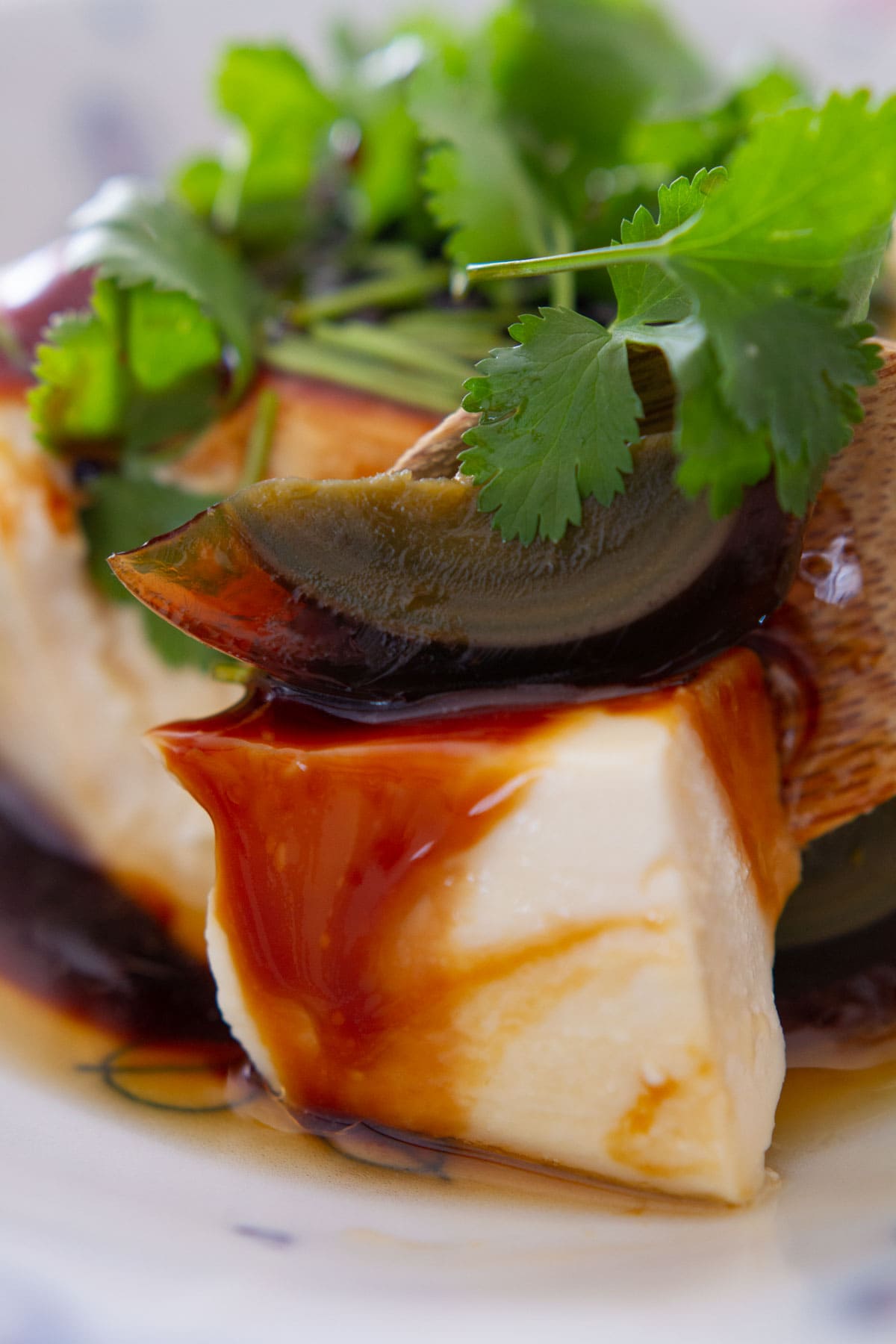
💭 faq
It does have a strong taste and that’s why it’s so delicious with silken tofu. Since tofu has a milder taste and tends to take on the flavor of whatever it’s paired with, the century egg’s distinct flavor is the perfect pairing.
Century eggs have a strong umami flavor that has a pungent quality, similar to strong cheese. The 'whites' have a deep savory flavor similar to aspic or meat jelly. It tastes similar to that gelatinous goodness that rotisserie chicken drippings form after being refrigerated.
That’s not all though, because so much of the century egg’s flavor experience has to do with its consistency. The egg white has a jelly texture while the yolk is creamy and almost like camembert or brie.
Century eggs are made by preserving the egg (typically duck eggs, but sometimes quail or chicken) in a mixture high in sodium and hydroxide to create a chemical reaction to alter the pH of the egg.
Traditionally, the eggs are soaked in a tea mixture, coated in a paste made of wood ash, salt, and calcium oxide, and wrapped in rice hulls or husks to cure. They’re then left in an airtight container for weeks, but sometimes months, to fully ferment.
This process causes the egg whites to turn black (or dark brown) and the egg yolk to dark green. While some people say it looks like the egg has gone bad, it’s perfectly safe (and delicious) to eat!
🍲 more recipes with tofu
Here are more recipes to show how versatile tofu can be!
🥢 pairing
Any of these dishes will pair well with century egg and tofu.
👨🍳 COOKING WITH KIDS
What can kid chefs help with?
- plopping the silken tofu out of its container and onto the plate
- instead of chopping the cilantro, your kid chef can rip it apart with their hands
- peeling the shell off of the century egg
Let me know if you have any questions in the comments below.
Happy cooking! ~ Cin
Want to get recipe updates, pro cooking tips, and nutrition info on East Asian ingredients straight to your inbox? Sign up here for a free PDF with cozy soup recipes.
Please give this recipe a star rating ⭐️⭐️⭐️⭐️⭐️ if you make it. I would love to hear from you! If you have any questions at all, let me know in the comments below.
simple century egg recipe with tofu 皮蛋豆腐 (1000 year old egg)
ingredients
- 1 (5 ounce) package silken tofu, (can substitute with soft tofu 豆腐)
- 1 century egg 皮蛋, (also called 1000 year old egg)
- 1 tablespoon soy paste
- 1 teaspoon sesame oil
- 10 sprigs fresh cilantro, washed and roughly chopped
*The Instacart button above is an affiliate link, which means we do make a small profit from your purchases (your price is not affected by this commission).
instructions
- Peel back the cover of the silken tofu container and drain the liquid over a bowl. If the cover is difficult to peel, kitchen sheers or a sharp paring knife will help.1 (5 ounce) package silken tofu
- Place a small serving plate or shallow bowl upside down over the top of the tofu container, then flip so that the container is upside down. Gently squeeze both sides of the container until the silken tofu is released.1 (5 ounce) package silken tofu
- Cut the century egg in half and peel the shell off. Then, slice each half into 4 wedges, making a total of 8 wedges.1 century egg 皮蛋
- Place sliced century egg on the serving plate next to the silken tofu, then top tofu with soy paste, sesame oil, and fresh cilantro. Serve cold immediately or chilled.1 tablespoon soy paste, 1 teaspoon sesame oil, 10 sprigs fresh cilantro
equipment and highlighted ingredients
notes
- Bonito flakes add a layer of smokiness and umami that pairs perfectly with this dish. I have seen it served this way at some Taiwanese restaurants.
- If you like spicy food like me, you can sprinkle on ½ teaspoon of thinly sliced Thai chili pepper.
- Garlic (minced or thinly sliced) can be mixed in with the soy paste or sprinkled on top of the tofu.
- Thinly sliced scallion also made a delicious addition, though I prefer cilantro.
- A sprinkle of toasted sesame seeds will enhance the nutty flavor of sesame oil. Use it sparingly though since it can easily overpower the soft tofu and century egg.
🌡️ food safety
Because this dish is considered a "ready-to-eat" item since it's a no-cook recipe, you'll want to wash your hands thoroughly or wear gloves when handling ingredients.
- Wash hands before handling ingredients, especially if they won't be cooked
- Don't leave food sitting out at room temperature for extended periods

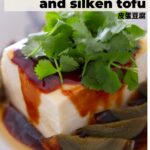
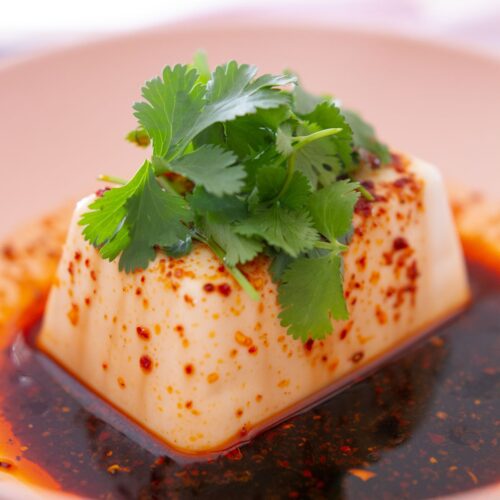
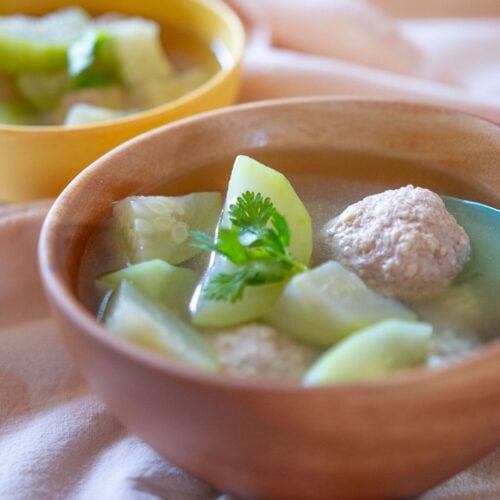
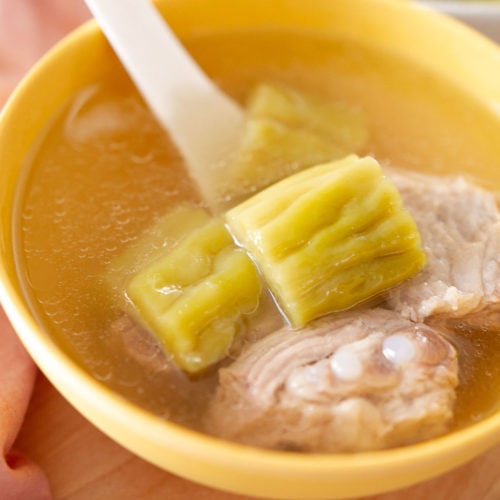
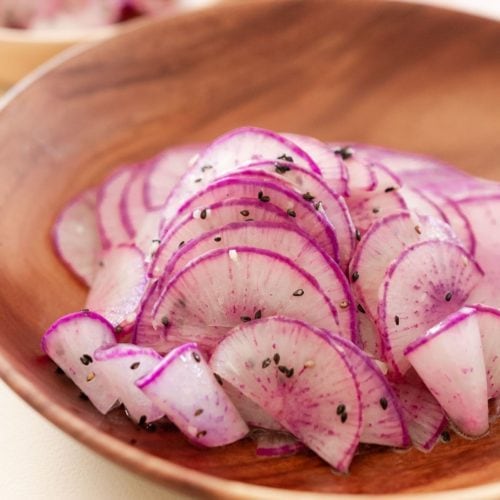
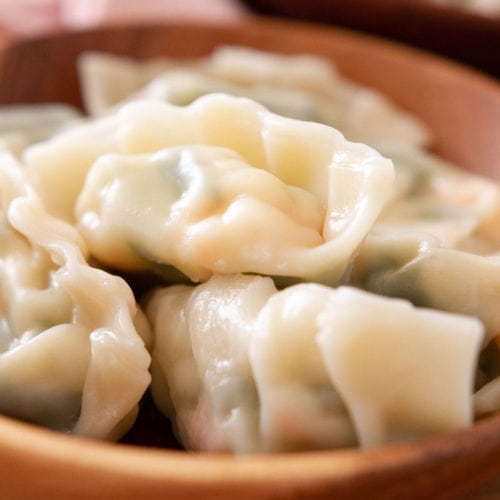
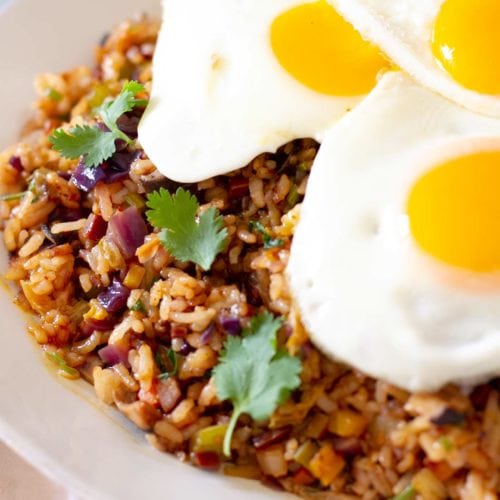
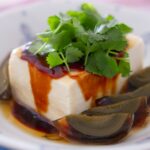
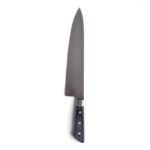
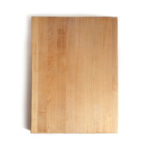

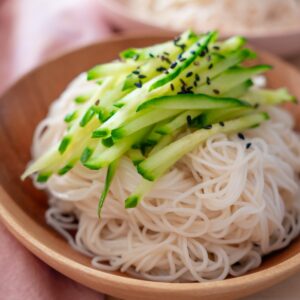
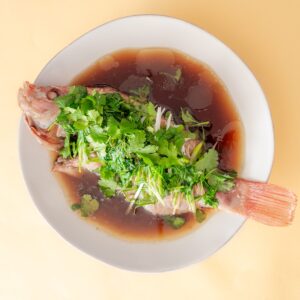
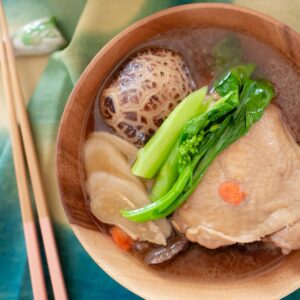
share your thoughts below. let's chat at the kitchen table: